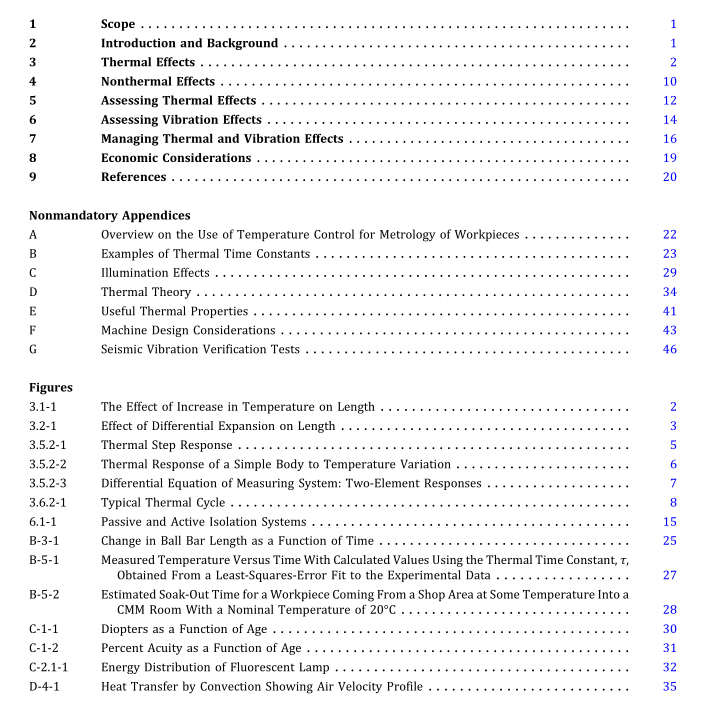ASME B89.4.21.1 pdf download

ASME B89.4.21.1 pdf download Environmental Effects on Coordinate Measuring Machine Measurements
1 scOPE
This Technical Report discusses important influences of the environment on dimensional and geometric measure-ments performed using coordinate measuring machines (CMMs) including influences on both the machine and theworkpieces to be measured.This Report discusses the thermal effects related to the use of tactile CMMs, but manyof these effects are also applicable to optical and other noncontact coordinate measurement systems.
2 INTRODUCTION AND BACKGROUND
2.1 Operating Conditions
JCGM 200 (ref.[1]) defines rated operating conditions (4.9) and limiting operating conditions (4.10).Machine speci-fications,typically stated as maximum permissible errors (MPEs), are intended to be applicable to a CMM that is usedwithin its rated operating conditions.These rated operating conditions are the conditions that must be fulfilled for themachine to perform as designed (i.e., meet the MPEs). These conditions include, but are not limited to, environmentalconditions.Limiting operating conditions are the extreme at which a machine can be operated withoutsustaining damageand without degradation of specifications when subsequently operated within its rated operating conditions.
2.2 Definition of Environment
For the purpose of this Technical Report, theCMM environment includes those elements in the machine surroundingsthat affect CMM system performance; effects of operators are not addressed in this Report. The environmental effectsincluded are temperature and humidity, illumination, vibration, electrical effects, and contamination.These effects arecaused or transmitted by surrounding air, building structure, other equipment, supply air, and the electrical system.For the purpose of this Technical Report, environments are classified as “laboratory” or “shop.” A laboratory envi-ronment is controlled in order to perform measurements at an acceptable accuracy level. A shop environment iscontrolled only to the level required to produce acceptable workpieces. A shop environment may not be acceptablefor performing measurement tasks.
2.3 Environmental Effects
The influence of environmental variables on the measurement results obtained using the CMM are classified as envir-onmentaleffects.The variables are identifiedin para.2.2, and their influence canvary greatly among different facilities,oreven within one facility. Whereas temperature and humidity mayvary depending on the time of day or season of the year,influences such as illumination, electrical noise, and vibration may be fairly constant for a given CMM installation.Contamination, either airborne or on the CMM and workpieces, may be either a steady-state or varying condition.The ability to manage contamination will depend on the nature of the installation and the perceived impact of thecontamination on measurement results.
Three main methods are employed to mitigate the influence of the environmental effects, as follows:
(a) Attempt to Remove the Source of the Influence. This may be done by shutting down or moving equipment causingvibration or removing heat sources from the immediate vicinity of the measuring equipment.
(b) Attenuate the Effects of the Influence. Vibration isolators may be used between the factory or laboratory floor andthe CMM, or baffles may be installed to block radiation from a heat source that cannot be moved.
(c) Compensate for the Influence. By using knowledge about how a particular influence effects the measurement andsensorsto quantify the environmentalstate, the measurementresults can be adjusted to compensate fortheenvironment.After mitigation,simply evaluate the influence; the uncertainty of measurement can be increased to accommodate theeffect of environmental influences where these methods are not employed.
2.4 Users of This Technical Report Theprimaryaudienceforthis TechnicalReportisbuyers andusersofCMMswho needto choosemachines andlevels of environmental control necessary for the anticipated measurement tasks, wherever they may be performed, as well as those who are responsible for using the CMM to make measurements. The users ofthis Technical Reportfall into the followingfour general categories (acknowledgingthatterminologyand job classifications vary from company to company and industry to industry): application engineer(measurementplanner): typicallythe person who designs fixtures, plans the measurementstrategy, purchases probe equipment, determines probe calibration frequency, and attimes writes the application programs. For additional information on measurement planners, see ASME B89.7.2 (ref. [2]). operator: an individual who actuallyprepares workpieces for measurement, places them in fixtures, decides iftheyhave been adequately thermally stabilized, operates the machine, and performs normal daily maintenance. NOTE: In some companies, the “application engineer” and the “operator” may be the same person. programmer: an individual whose primary responsibility is creating the necessary code (in the high-level language appropriate to a specific machine) to execute the measurement plan (this may be a separate job classification or its duties may be incorporated within application engineer, operator, or quality engineer). qualityengineer: an engineer that selects, acquires, and installs measuring systems, manages the use ofthe data coming from the systems, and plans and ensures the proper maintenance of the systems.









